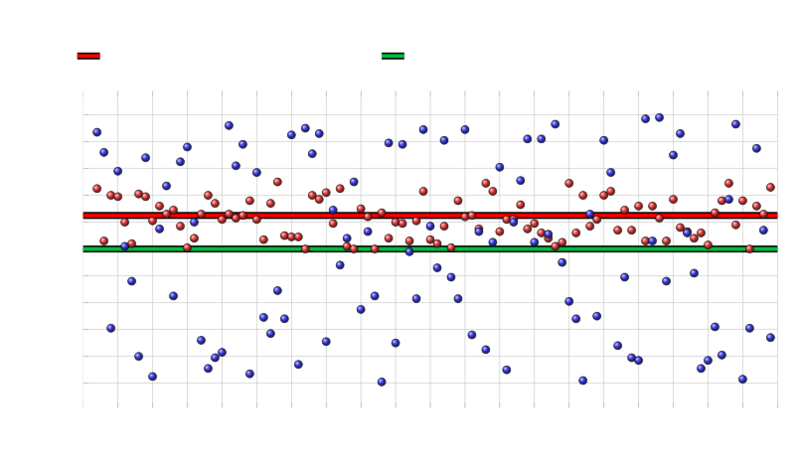The Diversity Prediction Theorem
The diversity prediction theorem is a powerful concept in the context of collective wisdom and decision-making, asserting that the aggregate prediction of a diverse group is more accurate than the average individual prediction. This theorem elegantly demonstrates the benefits of pooling knowledge from varied sources and can be elucidated as follows. Consider a crowd of individuals attempting to predict a certain value or outcome, such as the weight of an object, the outcome of an election, or the closing price of a stock. Each individual in the crowd produces a prediction, and the average of all these predictions is denoted as C. This collective estimate represents the "wisdom of the crowd."
The accuracy of this aggregate prediction can be assessed through the crowd's square error (CSE), which represents the squared difference between the average prediction C and the true value X: CSE = (C - X)²
The smaller the CSE, the more accurate the crowd's prediction. The diversity prediction theorem connects this measure of accuracy to two other key quantities: the crowd's diversity (D) and the mean square error (MSE). The crowd's diversity (D) reflects the variability in individual predictions, capturing the extent to which these predictions differ from one another. A diverse crowd features a wide range of opinions and perspectives, which can contribute to more accurate collective estimates. The mean square error (MSE) is the average of the squared differences between each individual's prediction and the true value X. This metric gauges the typical accuracy of individual predictions within the crowd.
According to the diversity prediction theorem, the relationship between these three quantities can be expressed as follows: CSE = MSE - D
Let us delve into the intricate details of this derivation and appreciate the beauty underlying this relationship.
| Conceptual Overview | Mathematical Expression |
|---|---|
| To begin, we reiterate the definition of the crowd's square error (CSE) as the squared difference between the average prediction (C) and the true value (X): | |
| Expanding this expression, we have: | |
| Now, observe that we can rewrite the expression for C² as the sum of individual predictions squared (x_i²) divided by the number of predictions (n), minus the same sum, plus 2C², and then subtract C²: | |
| This equation can be simplified to: | |
| Notice that the terms within the summations in the first and second brackets represent the squared differences between individual predictions and the true value (X), and between individual predictions and the average prediction (C), respectively: | |
| From this expression, we can identify the mean square error (MSE) as the average of the squared differences between each individual's prediction and the true value (X): | |
| Similarly, we recognize the crowd's diversity (D) as the average of the squared differences between each individual's prediction and the average prediction (C): | |
| With these definitions, we can rewrite the CSE equation as: |
This elegant and elaborate equation demonstrates the relationship between the crowd's square error (CSE), the mean square error (MSE), and the crowd's diversity (D). It confirms the diversity prediction theorem's assertion that the accuracy of the aggregate prediction improves with increased diversity within the crowd, as the CSE decreases when D increases. This mathematical foundation reinforces the importance of diverse perspectives and collaboration in harnessing the wisdom of the crowd for more accurate predictions and decision-making.
In exploring the intricacies of predictive accuracy, it becomes clear that diversity plays a crucial role. Imagine two groups tasked with making predictions about a future event. One group is quite homogeneous in its thinking, leading to a cluster of similar predictions. The other group is more diverse, with a wide array of estimates. Although the first group may be more confident, their predictions are narrowly centered, limiting their ability to accurately forecast a range of possibilities. On the other hand, the second group's diverse viewpoints result in a broader spread of predictions, increasing the likelihood that the true outcome falls within their range. This spread is not just a matter of chance; it is a reflection of the collective wisdom harnessed through diversity. Such a comparison underscores the theoretical proposition that a group's predictive success is directly linked to the variety of perspectives within it, making a compelling case for the value of diversity in collective decision-making processes.
In essence, the diversity prediction theorem highlights the power of diverse opinions in producing accurate collective estimates. By incorporating a wide range of perspectives and knowledge, the crowd can overcome individual biases, limitations, and errors, leading to a more precise understanding of the true value or outcome. This principle is at the heart of many successful decision-making processes, from democratic governance to financial markets and scientific collaborations, emphasizing the importance of inclusivity, open-mindedness, and collaboration in the pursuit of truth and wisdom.


![{\displaystyle CSE=\left[{\frac {\sum {(x_{i}^{2})}}{n}}\right]-2CX+X^{2}-\left[{\frac {\sum {(x_{i}^{2})}}{n}}\right]+2C^{2}-C^{2}}](https://wikimedia.org/api/rest_v1/media/math/render/svg/79d495b5dbf183ac989b5491c5274a78070ac334)
![{\displaystyle CSE={\frac {1}{n}}\left[\sum (x_{i}^{2}-2x_{i}X+X^{2})\right]-{\frac {1}{n}}\left[\sum (x_{i}^{2}-2x_{i}C+C^{2})\right]}](https://wikimedia.org/api/rest_v1/media/math/render/svg/9d6070b24ae7b25e61ceccdceb78b03752ead95d)
![{\displaystyle CSE={\frac {1}{n}}\left[\sum (x_{i}-X)^{2}\right]-{\frac {1}{n}}\left[\sum (x_{i}-C)^{2}\right]}](https://wikimedia.org/api/rest_v1/media/math/render/svg/1c28cd4cf51c7b7c662f517899e573649fe10750)
![{\displaystyle MSE={\frac {1}{n}}\left[\sum (x_{i}-X)^{2}\right]}](https://wikimedia.org/api/rest_v1/media/math/render/svg/000c70b110a9f68aec1dd7398567a4a7d9d6eb4c)
![{\displaystyle D={\frac {1}{n}}\left[\sum (x_{i}-C)^{2}\right]}](https://wikimedia.org/api/rest_v1/media/math/render/svg/678d747beb771d1771d38a6f8e0e1e548193f271)

